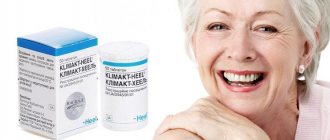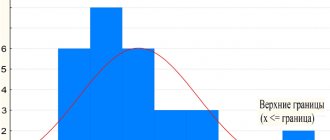Diseases of the stomach and gastrointestinal tract are accompanied by an increase in the secretion of gastric juice with an increased concentration of hydrochloric acid in it. With the help of the drug Renitidine, you can reduce the secretion of juice, and the drug is also used to treat many diseases of the gastrointestinal tract. Next, we will consider the composition of Ranitidine, as well as indications for use.
Help with stomach diseases
Ranitidine: release form - tablets
Ranitidine is a drug used to treat stomach ulcers and chronic gastritis; it belongs to the group of histamine receptor blockers. The acidic environment of the stomach negatively affects the mucous membrane and destroys its walls.
If the mucous membrane is affected by ulcers, the acidic environment can cause gastric bleeding. Bleeding occurs due to the destruction of the walls of blood vessels in the tissues of the stomach. The action of an acidic environment on an ulcer can cause a perforated ulcer, which results in peritonitis and inflammatory processes in the abdominal cavity.
The stomach walls sometimes break down after taking medications that contain acid, such as Aspirin. Stress often negatively affects the health of the entire body, including the stomach, causing heartburn. While taking the drug, there is a gradual decrease in the concentration of gastric juice and a decrease in hydrochloric acid in its composition.
The amount of gastric juice produced gradually decreases. This allows you to get rid of the unpleasant burning sensation in the stomach and reduce pain. By acting on receptors, the drug stimulates the renewal of the mucous membrane and triggers the protective properties of cells by enhancing their microcirculation.
The drug is available in film-coated tablets and in the form of a solution.
Tablets can be prescribed without a doctor's prescription. The solution is used in hospitals to treat patients with stomach diseases, as well as to regulate digestive processes in the postoperative period.
Ranitidine
Ranitidine
(lat.
ranitidine
) - an antiulcer drug, a blocker of histamine H2 receptors. Historically, it is the second (after cimetidine) antisecretory drug that suppresses acid production in the stomach. It is currently considered relatively old, has more side effects than modern drugs and is less effective than famotidine and proton pump inhibitors. In the fall of 2022, a number of drugs containing ranitidine were banned for use or approval for their use in clinical practice was temporarily suspended by regulators in many countries due to the presence or suspicion of the presence (the latter motivated by unsatisfactory testing of the drug for this ingredient) of potential carcinogen - N-nitrosodimethylamine.
The FDA, in its release dated April 1, 2022, required that all drugs containing ranitidine be removed from use and sale in US pharmacies due to the fact that when stored at temperatures above room temperature, drugs containing ranitidine may increase the amount of N-nitrosodimethylamine in some of them .
Ranitidine is a chemical compound
N-[2-[[5-(Dimethylaminomethyl)furfuryl]thio]ethyl]-N'-methyl-2-nitro-1,1-ethenediamine hydrochloride. Empirical formula: C13H22N4O3S.
Ranitidine is a drug
Ranitidine is the international nonproprietary name (INN) of the drug. According to the pharmacological index, it belongs to the group “II generation H2-histamine receptor blockers”. According to ATC, it belongs to the group “H2-histamine receptor blockers” and has the code A02BA02.
Pharmacodynamics of ranitidine
Ranitidine is a blocker of histamine H2 receptors on parietal cells of the gastric mucosa. Reduces basal and stimulated secretion of hydrochloric acid caused by irritation of baroreceptors, food load, the action of hormones and biogenic stimulants (gastrin, histamine, pentagastrin). Ranitidine reduces the volume of gastric juice and the content of hydrochloric acid in it, reduces the acidity of the stomach, which leads to a decrease in pepsin activity. The duration of action of ranitidine after a single dose is up to 12 hours.
Pharmacokinetics of ranitidine
When taken orally, the bioavailability of ranitidine is 50%. Plasma protein binding does not exceed 15%. Partially metabolized in the liver. Maximum concentrations of ranitidine in plasma are achieved 2 hours after taking film-coated tablets, 1 hour after taking effervescent tablets and range from 36 to 94 ng/ml. The half-life is 2-3 hours. About 30% of the administered dose of ranitidine is excreted unchanged in the urine, and a small amount is excreted in the feces. Penetrates through the placenta. Excreted in breast milk.
Professional medical work covering the treatment of gastrointestinal diseases with ranitidine
- Gorbakov V.V., Makarov Yu.S., Golochalova T.V. Comparative characteristics of antisecretory drugs of various groups according to daily pH monitoring // Attending physician. 2001. – No. 5–6.
- Yakovenko E.P. Zantac in the treatment of acid-related diseases. RGMU, Federal Gastroenterological Center, Moscow.
- Makhakova G.Ch., Dicheva D.T., Odintsova T.A. and others. Comparative characteristics of acid-suppressing drugs by conducting pharmacological tests with intragastric daily pH-metry // Attending physician. – 1999. – No. 6. – P. 24–26.
On the website gastroscan.ru in the literature catalog there is a section “H2-blockers”, containing articles devoted to the treatment of diseases of the gastrointestinal tract using H2-blockers of histamine receptors, including the use of ranitidine.
Indications for use of ranitidine
- treatment and prevention of exacerbations of gastric and duodenal ulcers;
- stomach and duodenal ulcers associated with taking NSAIDs;
- reflux esophagitis, erosive esophagitis;
- Zollinger-Ellison syndrome;
- treatment and prevention of postoperative, “stress” stomach ulcers;
- prevention of recurrent bleeding from the upper gastrointestinal tract;
- prevention of aspiration of gastric juice during operations under anesthesia (Mendelssohn syndrome).
Method of administration of ranitidine and dose
- Peptic ulcer of the stomach and duodenum. To treat exacerbations, ranitidine is prescribed 150 mg 2 times a day (morning and evening) or 300 mg at night. If necessary, 300 mg 2 times a day. The duration of treatment is 4-8 weeks. To prevent exacerbations, 150 mg is prescribed at night.
- Ulcers associated with NSAIDs. Prescribe 150 mg of ranitidine 2 times a day or 300 mg at night for 8-12 weeks. Prevention of ulcer formation when taking NSAIDs - 150 mg 2 times a day.
- Postoperative ulcers. Prescribe 150 mg of ranitidine 2 times a day for 4-8 weeks.
- Gastroesophageal reflux disease. Prescribe 150 mg 2 times a day or 300 mg at night. If necessary, the dose can be increased to 150 mg 4 times a day. The course of treatment is 8-12 weeks.
- Zollinger-Ellison syndrome. The initial dose is 150 mg ranitidine 3 times a day, the dose can be increased if necessary.
- Prevention of recurrent bleeding. 150 mg 2 times a day.
- Prevention of the development of Mendelssohn's syndrome. Ranitidine is prescribed at a dose of 150 mg 2 hours before anesthesia, and also, preferably 150 mg the night before.
Ranitidine is taken regardless of meals, without chewing, with a small amount of liquid.
Effervescent tablets are dissolved in a glass of water and drunk after complete dissolution.
For patients with renal failure with creatinine clearance less than 50 ml/min, the recommended dose is 150 mg of ranitidine per day.
Experience with the use of ranitidine in the treatment of functional heartburn
The updated American Gastroenterological Association functional heartburn guidelines (2020) present results from treating patients with functional heartburn with ranitidine 150 mg daily. It is noted that ranitidine has an analgesic effect by reducing the sensitivity of esophageal chemoreceptors to acid perfusion (Fass R., Zerbib F., Gyawali CP).
Precautions when using ranitidine
- It is undesirable to abruptly stop taking ranitidine due to the risk of relapse of peptic ulcer disease.
- Ranitidine should be used with caution in patients with impaired renal and hepatic function.
- Before starting treatment with ranitidine, it is necessary to exclude the possibility of a malignant disease of the esophagus, stomach or duodenum.
Contraindications to the use of ranitidine
Hypersensitivity to ranitidine or other components of the drug. Pregnancy, lactation. Children's age up to 14 years.
Side effects of ranitidine
- From the nervous system and sensory organs: headache, feeling of fatigue, dizziness, drowsiness, insomnia, vertigo, anxiety, depression; rarely - confusion, hallucinations (especially in elderly and weakened patients), reversible blurred vision, impaired accommodation of the eye.
- From the cardiovascular system and blood (hematopoiesis, hemostasis): arrhythmia, tachycardia, bradycardia, AV block, decreased blood pressure; reversible leukopenia, thrombocytopenia, granulocytopenia; rarely - agranulocytosis, pancytopenia, sometimes with bone marrow hypoplasia, aplastic anemia; sometimes - immune hemolytic anemia.
- From the gastrointestinal tract: nausea, vomiting, constipation, diarrhea, abdominal discomfort, pain; rarely - pancreatitis. Sometimes - hepatocellular, cholestatic or mixed hepatitis with/without jaundice (in such cases, ranitidine should be stopped immediately). These effects are usually reversible, but in rare cases they can be fatal. Rare cases of liver failure have also been reported. In healthy volunteers, AST concentrations were increased by at least 2-fold relative to pre-treatment levels in 6 of 12 people receiving 100 mg 4 times IV for 7 days and in 4 of 24 people receiving 50 mg 4 times IV for 5 days.
- From the musculoskeletal system: rarely - arthralgia, myalgia.
- Allergic reactions: skin rash, bronchospasm, fever, eosinophilia; rarely - erythema multiforme, anaphylactic shock, angioedema.
Ranitidine interactions
Antacids, sucralfate in high doses (2 g) slow down the absorption of ranitidine (when used simultaneously, the interval between taking antacids and ranitidine should be at least 1-2 hours).
Smoking reduces the effectiveness of ranitidine. Additional prolongation of PT has been reported when ranitidine was coadministered with warfarin; however, in human pharmacokinetic studies at a ranitidine dose of 400 mg/day, no interaction was observed; ranitidine had no effect on the clearance of warfarin and PT; the possibility of interaction with warfarin at doses above 400 mg per day has not been studied. When administered twice daily with ranitidine and triazolam, plasma concentrations of triazolam were higher than when administered with triazolam alone. Triazolam AUC values in people 18–60 years of age were 10 and 28% higher after administration of ranitidine 75 and 150 mg tablets than after administration of triazolam alone. In patients over 60 years of age, AUC values were approximately 30% higher after taking ranitidine 75 and 150 mg tablets. Ranitidine increases the AUC (by 80%) and concentration (by 50%) of metoprolol in the blood serum, while the half-life of metoprolol increases from 4.4 to 6.5 hours. Reduces the absorption of itraconazole and ketoconazole (ranitidine should be taken 2 hours after taking them). Inhibits the metabolism of phenazone, hexobarbital, glipizide, buformin, BCC. Compatible with 0.9% sodium chloride solution, 5% dextrose solution, 0.18% sodium chloride solution and 4% dextrose solution, 4.2% sodium bicarbonate solution. When taken simultaneously with drugs that depress bone marrow, the risk of developing neutropenia increases. Possible interaction with alcohol. When taken together with loperamide, serious heart problems are possible (FDA Notice dated 6.7.2916).
Ranitidine overdose
- Symptoms: convulsions, bradycardia, ventricular arrhythmias.
- Treatment: induction of vomiting or gastric lavage, symptomatic therapy. For convulsions - intravenous diazepam, for bradycardia - atropine, for ventricular arrhythmias - lidocaine.
Use of ranitidine during pregnancy and lactation
Ranitidine is contraindicated for use during lactation. FDA category of risk for the fetus when used throughout pregnancy is B (animal studies have not revealed a risk of adverse effects on the fetus; there have been no adequate studies in pregnant women).
general information
By Decree of the Government of the Russian Federation of December 30, 2009 No. 2135-r, ranitidine (solution for intravenous and intramuscular administration; solution for injection; film-coated tablets; film-coated tablets) is included in the List of vital and essential medicines.
Trade names of drugs containing the active ingredient ranitidine
Having or having been registered in Russia: Asitek, Acidex, Atsilok, Vero-Ranitidine, Gistak, Zantac, Zantin, Zoran, Raniberl 150, Ranigast, Ranisan, Ranison, Ranitidine, Ranitidine-LekT, Ranitidine Vramed, Ranitidine SEDICO, Ranitidine-AKOS, Ranitidine-Acri, Ranitidine-BMS, Ranitidine-ratiopharm, Ranitidine-Ferein, Ranitidine hydrochloride, Ranitidine film-coated tablets, Ranitin, Rantag, Rantak, Ranks, Ulkodin, Ulran, Yazitin from the following manufacturers: Akrikhin HFC, Russia;
Bryntsalov-A, Russia; Wave International, India; Vector, Russia; Vector-Farm, Russia; Vertex, Russia; J.R. Sharma Overseas, India; Health UKR, Ukraine; Irbit Chemical and Pharmaceutical Plant, Russia; Kanonpharma production, Russia; Krka, Slovenia; Moskhimfarm-preparations named after. ON THE. Semashko, Russia; Natur Product, France; Natur Product Europe B.V., the Netherlands; Ozon, Russia; Olainfarm, Latvia; Panacea Biotech, India; Northern Star, Russia; Serena Pharma/Shreya Life Sciences, India; HEMOPHARM CONCERN A.D., Yugoslavia. The Zantac brand of ranitidine is registered in the USA: prescription Zantac 150 USP, Zantac 300 USP, Zantac 25 EFFERdose, Zantac Syrup USP and over-the-counter Zantac 75, which has a reduced content of ranitidine - 75 mg and is approved for self-treatment of heartburn.
Instructions from manufacturers
Some instructions for the medical use of drugs with the only active ingredient - ranitidine (pdf):
- For Russia:
- "Ranitidine-Akri", film-coated tablets, 150 mg, JSC "Akrikhin",
- "Zantac 150 (ranitidine hydrochloride) Tablets, USP. Zantac 300 (ranitidine hydrochloride) Tablets, USP. Zantac 25 (ranitidine hydrochloride effervescent) EFFERdose Tablets, USP. Zantac (ranitidine hydrochloride) Syrup, USP. Prescribing Information". GlaxoSmithKline, January 2011
Ranitidine has contraindications, side effects and application features; consultation with a specialist is necessary. Back to section
Use for the treatment of ulcers and gastritis
For the treatment of peptic ulcers and the acute phase of chronic gastritis, the drug is taken twice a day at a dosage of 150 mg. According to the doctor's indications, a one-time dose of 300 mg may be taken at night. Treatment is carried out with one drug or in combination with other drugs for a course of at least a month. You can use the drug as a prophylaxis for stomach diseases, then the course and dosage is determined by a gastroenterologist.
Recommend me something for heartburn that will last longer.
Modern antacid drugs that are not absorbed in the digestive tract, such as aluminum phosphoric acid or aluminum-magnesium drugs, are suitable for you. They bind hydrochloric acid quite quickly - usually within a few minutes after ingestion - and their effect lasts up to several hours. Maximum duration of action
characteristic of drugs containing aluminum hydroxide. They act for 2.5–3 hours [2].
Use for diseases of the esophagus
In diseases of the esophagus, in most cases, damage to its walls occurs with gastric acid due to insufficiency of the sphincter, which ensures compression of the lumen that closes the entrance to the stomach. Frequent releases of acidic contents damage the mucous membrane of the esophagus and purulent foci, as a result of inflammation, and ulcers form on its walls.
Such diseases include reflux esophagitis. Its symptoms include frequent and prolonged pain, heartburn, bad breath and belching. The disease is accompanied by neuroses and sleep disturbances. Taking Ranitidine relieves burning and pain, restores the mucous membrane by regulating the secretion of gastric juice and stimulating the work of the sphincter.
The drug is taken in the same dosage as for gastritis and ulcers - 300 mg; for severe pain, you can double the daily dose - 600 mg, in this case the medicine is taken 4 times.
Treatment of other diseases
Ranitidine is produced by different pharmaceutical companies
The drug can be used for erosive and ulcerative lesions of the intestines, benign neoplasms accompanied by heartburn. Tumors can affect the excess of the hormone gastrin in the body, which stimulates the production of gastric juice.
This can cause intestinal ulcers called Zollinger-Ellison syndrome. The drug restores the mucous membrane and slows down ulcerative manifestations. The drug is prescribed for this disease in a daily dosage of 450 mg, the dose is divided into three times.
How to choose the right analogue?
Many patients try to select analogues of drugs prescribed by gastroenterologists. If they differ only in price and the active ingredients are similar, consulting a doctor is not necessary. If there is a difference in the active component, the effect on the body, or the risk of side effects, laboratory and instrumental testing is first carried out. Blood, urine, feces, and gastrointestinal morphology are examined.
If you change the drug without the recommendation of a gastroenterologist, negative reactions may occur not only for the gastrointestinal tract, but also for any part of the body.
For example, if a patient evaluates which is better, Ranitidine or Omeprazole, consultation with a doctor is required. The drugs contain different active ingredients that can cause negative effects. Many medications provoke neurological disorders, dysfunction of the gastrointestinal tract, genitourinary, and biliary systems. It will be necessary to additionally eliminate the negative disorders that have arisen.
If the substitute is chosen correctly, gastrointestinal function is normalized when using the first dose. The secretion of hydrochloric acid is reduced, the development of erosion and ulcers on the surface of the mucous membrane is prevented. Patients stop experiencing heartburn, which causes damage to the esophagus and stomach. Patients with peptic ulcer disease may experience remission, especially with the combined use of several prescribed drugs.
Side effect
The drug may have side effects due to its improper use, dosage violations and non-compliance with instructions. Side effects:
- Poor appetite
- Nausea
- Vomit
- Constipation
- Rarely tinnitus
- Increased blood pressure
- Dry mouth
- Headache
- Fatigue
- Violation of potency
- Muscle pain
- Quincke's edema
- Bronchial spasm
- Interaction
- Reduces the effect of Ketonazole
- Inhibits metabolism: Aminophenazone, Thiophylline, Lidocaine, Diazepam, Metronidazole
Compatible with:
- Sodium chloride
- Dextrose
- Sodium bicarbonate
Give me heartburn medicine. And it would be desirable to also help with bloating - are there any such remedies?
Yes, today there are combination drugs that simultaneously neutralize hydrochloric acid and stop the manifestations of flatulence due to the inclusion of simethicone in the antifoam composition. It reduces the surface tension of gas bubbles in the digestive tract, promoting their rupture. An example of such a drug is a combination of aluminum, magnesium hydroxide and simethicone in the form of a suspension. It simultaneously neutralizes hydrochloric acid, reduces gas formation in the intestines, and also envelops the mucous membrane of the digestive tract, protecting it from the damaging effects of aggressive substances [5].
Contraindications for use
Ranitidine for stomach relief is not prescribed for:
- increased individual sensitivity to the active substance and excipients of the drug,
- malignant neoplasms of the stomach,
- liver cirrhosis and liver failure,
- severe renal failure.
The drug is not used during pregnancy, since the drug penetrates the placenta barrier, and the risk of affecting the fetus cannot be ruled out. Doctors do not use the medicine in the treatment of women who are breastfeeding, because the instructions say that the medicine is absorbed into breast milk. The drug is not used to treat children under twelve years of age.
Note!
The description of the drug Ranitidine on this page is a simplified author’s version of the apteka911 website, created on the basis of the instructions for use.
Before purchasing or using the drug, you should consult your doctor and read the manufacturer's original instructions (attached to each package of the drug). Information about the drug is provided for informational purposes only and should not be used as a guide to self-medication. Only a doctor can decide to prescribe the drug, as well as determine the dose and methods of its use.
Why has Ranitidine disappeared from pharmacies?
Ranitidine is the international nonproprietary name. Like, for example, acetylsalicylic acid. And there are many more trade names of drugs that contain this acetylsalicylic acid. In the territory of the former Soviet Union, ranitidine is represented by about 50 trade names. So why is there no ranitidine on the market? Now let's look at the composition. Raw materials are produced for the production of the drug. The raw materials are produced by some huge factory. And then a certain plant, which is located in India, produced raw materials for the production of ranitidine, and it was bought by a bunch of different companies. And in this raw material a component was found that is a carcinogen, i.e. causes cancer. And, accordingly, all these ranitidine preparations, with different trade names, made from this raw material, are theoretically dangerous.
Nobody says that if you take a ranitidine tablet tomorrow, something will happen to you.
But since the drug is very common, self-respecting companies, having discovered that the permissible concentration of carcinogens in their medicine exceeds the permissible concentration, withdraw the drug from sale. There are variants of ranitidine that do not contain this raw material, and they can be used. There are those that are not allowed.
But by and large, no one wants to take the risk, and more and more doctors are stopping prescribing ranitidine. What should patients do? To date, ranitidine and its group of drugs are not considered the most effective drugs for combating high stomach acidity. There are more effective drugs called proton pump inhibitors.





